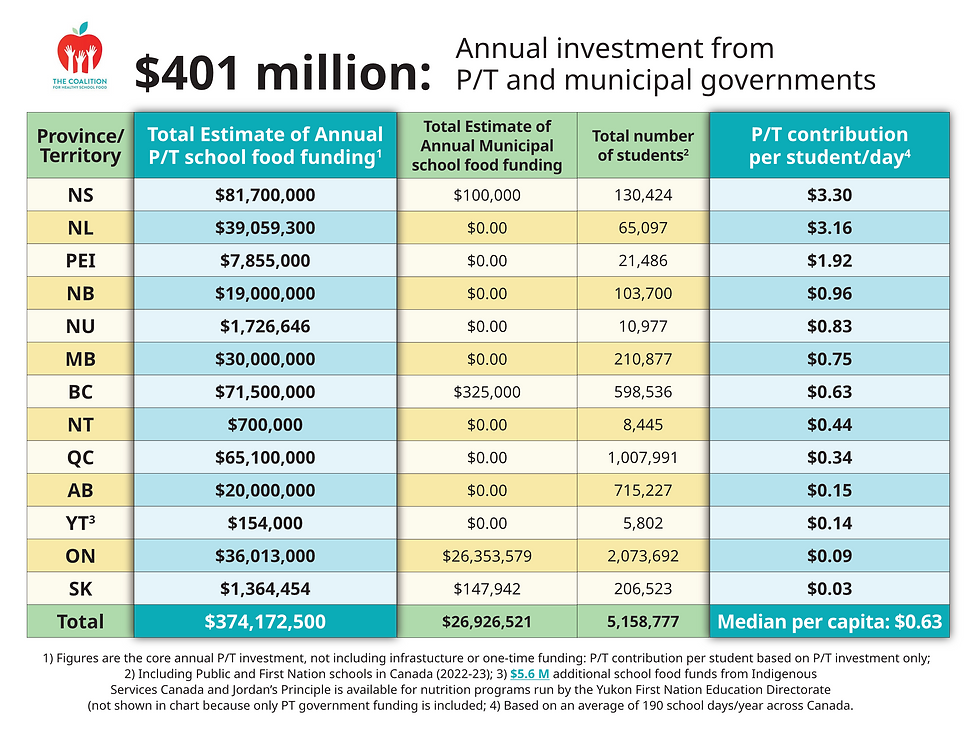Provinces, Territories, Municipalities invest $400M+ annually in school food
- Jun 2
- 4 min read
Updated: Jul 7
By: Sarah Keyes, Provincial Lead, Ontario Chapter of the Coalition for Healthy School
The Coalition for Healthy School Food has been collecting data on provincial, territorial, and municipal investments in school food.
As of the 2025–26 school year, we're excited to share that the combined investment from provinces, territories, and municipalities (PTM) is projected to be $401 million annually, a collective increase of over $115 million compared to last year.
Chart 1 includes the estimated amount of funding provided by each province, territory and municipality.

The chart’s 5th column demonstrates the provincial and territorial investment per capita, showing the funding available per meal per day if every student in the province or territory was participating in the school food program (universal participation).[1] As of 2025-26, the national per capita median investment among the 13 provinces and territories is 63¢ per student per day, compared to 39¢ per student per day in 2024-25.[2] Chart 1 shows that East coast provinces (NS, NL, PEI, and NB) are leading the way when it comes to per capita school food funding.
PTM governments are investing in school food to build a more robust social safety net and respond to on-going food inflation (the #1 source of financial stress for Canadian families). Universal, stigma-free school food programs support children from all income backgrounds to meet their daily nutritional requirements, provide relief to families' household budgets, and support a growing number of children and youth unable to access nutritious food at home.
British Columbia and some other PTs are also taking advantage of school food’s public purchasing power as a way to strengthen local and regional food systems and boost their economies.
Noteworthy school food investments in 2025 include:
The Government of Newfoundland and Labrador committed an additional $24 million in their 2025 Budget, for a total provincial investment of over $39 million in the 2025-26 school year. The funding will support the expansion of lunch programs from Pre-K to Grade 9 schools, in addition to breakfast programs.
The Nova Scotia government announced an additional $61.3 million in Budget 2025 to expand their pay-what-you-can lunch program to an additional 77 middle and junior high schools. This brings the total lunch program budget to $80 million annually, with an additional $1.7 million/year allocated to breakfast programs. NS is now the highest PT contributor per capita, investing $3.30 per student per day in school meals.
The New Brunswick government committed $19 million in Budget 2025 to develop a lunch program that will “leverage local foods when possible” with the goal of supporting students to be ready to learn. Federal funds through the national school food program agreement will also support breakfast programs in NB.
The Government of Prince Edward Island further expanded their pay-what-you-can lunch program by adding $2.5 million in Budget 2025. The total provincial investment is now $7.5 million annually.
In Budget 2025, the Manitoba government pledged to make their universal school food program permanent by embedding school food into Nello’s law so no future government can cut the $30 million per year provincial investment. MB funding supports existing and new school food programs, and provides grants for after school and summer food programs.
In October 2024, the City of Toronto, under the leadership of Mayor Chow, committed to a universal morning meal for every student in Toronto by September 2026, and a universal lunch by 2030. Toronto increased annual funding by $6.9 million for a new total of $26 million, and also requested that the Government of Ontario increase its school food funding after declaring a food insecurity emergency in December.
Several municipalities in Ontario began to fund school food programs in 2024-25, including Cambridge, Hamilton, Kingston and Norfolk. They join other cities like Ottawa, Brantford, and Prince Edward County that support their local Student Nutrition Programs.
We’re thrilled to see several PTMs continuing to step up to invest in school food. So many folks are working hard to develop and enhance programs based on the Coalition’s guiding principles and the National School Food Policy. This collective action is having tangible impacts on the lives of children and youth by improving learning, health, and mental wellbeing.
We hope that the momentum continues to build in all provinces and territories until we reach our Coalition’s vision of a universal school food program in Canada that is cost-shared among federal, provincial, municipal governments, as well as parents and community donors. We will keep working towards more investments from PTs who are falling behind, as well as growing municipal funding commitments, so that PTMs can build on the national school food program funding and build comprehensive programs so they too can benefit from the social and economic impacts of investing in school food.
***
[1] P/T/M funding amounts were obtained from publicly available online sources, including provincial and municipal budgets, Dr. Ruetz’s 2025 report, national school food program agreements, and in some cases direct communication with school food providers. P/T/M investments listed include the most recent school year available through these sources, ranging from 2023-24 to 2025-26. A full list of references can be found here.
[2] We used the median per capita investment to find the central tendency of the dataset to ensure the figure was not skewed by outliers.




Comments